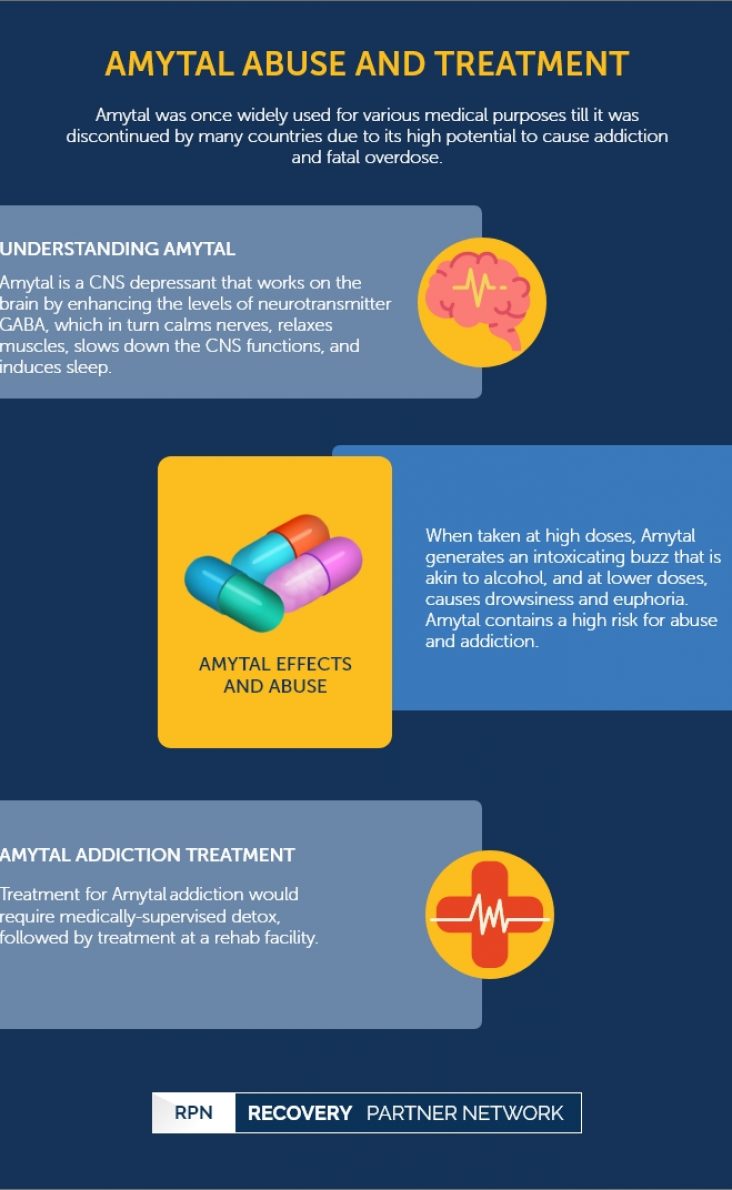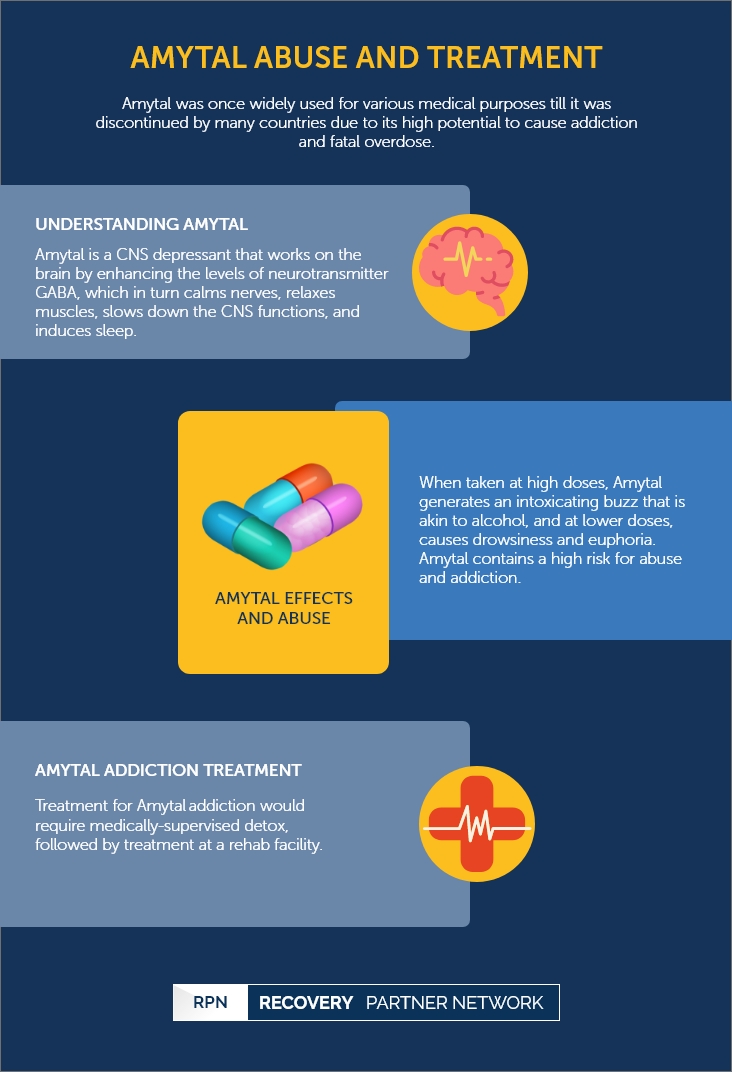Amytal was once widely used for various medical purposes till it was discontinued by many countries due to its high potential to cause addiction and fatal overdose.
Amytal Abuse and Treatment
Amobarbital addiction | Table of Contents
Understanding Amytal
Amytal is the brand name of the barbiturate derivative, known as amobarbital. It is a central nervous system depressant that works on the brain by enhancing the levels of neurotransmitter GABA, which in turn calms nerves, relaxes muscles, slows down the CNS functions, and induces sleep. Under general circumstances, barbiturates are used as pre-anesthetic for medical surgeries and to treat sleep disorders. At high doses, Amytal is also used as an anesthetic. Amidst controversies, Amytal has also been used as a “truth serum” in various psychiatric interviews and criminal interrogations.
Some of the street names for Amytal are:
- Downers
- Red
- Redbirds
- Blue devils
- Heavenly blues
- Blue heaven
- Bluebirds
- Blue velvets
- Lilly 33s
Barbiturates, including Dexamyl, Amytal, and Tuinal, were the most widely abused drugs in the US between 1930 and 1990. Many individuals were increasingly addicted to barbiturates, out of which many even died due to overdose. Celebrities such as Jimi Hendrix and Marilyn Monroe were also a few of the victims of a fatal barbiturate overdose during this period. However, in the 1970s, barbiturates were soon replaced with the introduction of a new class of sedative-hypnotics, called benzodiazepines, which contained a low risk of addiction and overdose. In the early 2000s, amobarbital pills, including Tuinal and Dexamyl, were also removed from markets and made legal only for intravenous applications. However, the tablet version of Amytal is still available on the streets illegally. Individuals who obtain Amytal illegally may face extremely harsh penalties under federal law.
Currently, the US is the only country to continue using barbiturates for medical purposes. Some medical professionals still prefer Amytal due to its potency, effectiveness, and fast-acting properties. The most common legal dose for sedation is 15 to 50 mg, and 65 to 200mg for sleep. Increasing this legal dose by at least a few grams without medical advice can be hazardous.
FAQ
- What is Amytal used for?
- Is Amobarbital (Amytal) an acid or base?
- What type of drug is Amytal?
- Is sodium Amytal a truth serum?
Amytal is primarily used as a short-term treatment for insomnia.
Amobarbital sodium falls under the pharmaceutical class of barbiturates. Therefore it has alkaline properties qualifying the drug as a base. The basic structure of Amobarbital sodium is barbituric acid that does not have CNS activity.
Amytal Sodium falls under the barbiturates category.
Sodium Amytal is a powerful sedative that causes side effects such as cognitive impairment and confusion. Therefore, it falls under the same category as other truth serum drugs.
Amytal Effects and Abuse
Amytal has been classed as a Schedule II drug under the Controlled Substances Act, implying that it has medical purposes but also contains a high risk for abuse and addiction. When taken at high doses, Amytal generates an intoxicating buzz that is akin to alcohol, and at lower doses, causes drowsiness and euphoria.
Barbiturates abuse, especially Amytal, is quite prevalent amongst alcoholics due to the similarities of their effects. There have been reports of Amytal being used by alcoholics, as it provides a similar intoxication to alcohol without an alcoholic breath or smell. Individuals abusing stimulants, such as cocaine and methamphetamine, also abuse Amytal or other barbiturates frequently to come down from hyper-stimulation and induce a state of calm. Amytal is usually abused by either snorting the white powder or diluting it in water to inject it.
Some of the signs of Amytal abuse are:
- Nausea and vomiting
- Dizziness
- Mental confusion
- Headaches
- Extreme sleepiness
- Anxiety
- Fever
- Insomnia
- Tremors
- Poor insight and judgment
- Slow and slurred speech
- Unsteady gait
- Poor co-ordination
- Lack of inhibitions
- Euphoria
- Muscle weaknesses
- Shallow breathing
- Impaired motor function
- Blackouts
- Calmness
- Over-confidence
- Memory loss
- Drastic changes in behavior
- Appearing sluggish, slow, and drugged
- Neglecting responsibilities at work, home, or school
- Frequently visiting hospitals with fake illnesses to obtain more Amytal
- Engaging in risky behaviors, such as driving while under the influence
Even though Amytal is considered therapeutic in monitored and supervised doses, it still holds a high risk of causing an overdose due to its potency. Amytal can depress brain functions to the extent of causing breathing difficulties that can lead to a coma or even death. Combining Amytal with other CNS depressants such as alcohol can also increase the risk of an overdose.
The heavy use of central nervous system depressants can also cause an individual to vomit while sleeping. This can cause difficulties in releasing the vomit due to the suppression of cough and gag reflexes, causing him/her to choke on the vomit.
FAQ
The sodium amytal test (Wada test) can assist epilepsy doctors in figuring out how crucial each side of the brain is in relation to memory and language. During the test process, the physicians put one side of the brain to sleep temporarily by injecting sodium amytal into the carotid artery. Both sides of the brain are subjected to this test, and the results are compared.
Some of the approved uses of Amobarbital (Amylobarbitone) are for the treatment of anxiety disorder and other mood disorders, to treat seizures, short-term treatment for insomnia, and the Wada test.
Signs of an Amytal Addiction
Amytal use can rapidly develop into addiction without the user being aware of the problem. Individuals with an Amytal addiction may doctor-shop to acquire more of the drug or turn to street vendors to purchase illegal Amytal pills. Individuals who continue to use this medication will rapidly form a physical and psychological dependence on Amytal. Since Amytal modifies the brain’s natural chemistry, regular use of it, usually for two weeks or longer, can result in the formation of tolerance. During this stage, users will require increasingly large doses of Amytal to attain the desired effects. Individuals who form tolerance and dependence on Amytal will require the drugs to function normally on a daily basis.
Medical professionals utilize the criteria outlined in the Diagnostic and Statistical Manual of Mental Disorders (DSM-V) to identify addictions in individuals and to help diagnose the severity of their substance use disorder.
Amytal Abuse Statistics
- Nearly 1 out of every ten individuals who overdose on barbiturates or barbiturate mixtures die as a result of it.
- About 9 percent of high school students have abused barbiturates at least once in their lifetime.
Amytal Addiction Treatment
Considering the chemical changes that occur due to barbiturates such as Amytal, it can be extremely risky to quit cold-turkey. Amytal can cause severe and life-threatening withdrawal symptoms that would require medically-supervised detox to effectively eliminate Amytal or any other drugs from the patient’s body safely. Although Amytal addiction is less common than most other addictions, there are various treatment options available to treat it adequately.
Amytal withdrawal symptoms may include:
- delirium
- hallucinations
- seizures
- muscle pains
- nausea
- vomiting
- anxiety
- mental confusion
Inpatient Rehab for Amytal
Inpatient treatment offers patients around the clock supervised residential care void of all distractions and temtataions to help patients solely focus on their recovery. Inpatient treatment provides both psychiatric and physical healthcare assistance to patients over a period of 30 to 90 days. Patients are usually required to undergo a substance abuse assessment by an addiction treatment specialist before admission to determine if he/she meets the criteria needed to enroll in the program.
Some of the various benefits of inpatient programs are:
- Encouragement and support from other recovering patients who are facing the same challenges.
- The ability to communicate your challenges with therapists while trying to unveil the root causes of the addiction.
- The ability to partake in family therapy to improve and repair strained relationships.
- The ability to invest in yourself to improve your physical and mental health.
- Education on the disease of addiction and healthy coping skills, including relapse prevention strategies.
Outpatient Rehab for Amytal
Outpatient treatment is an alternative to inpatient treatment that can be most benefitting for patients with work, school, or family commitments. Outpatient treatment is also recommended as aftercare or step-down program after the successful completion of an inpatient program.
There are various outpatient treatment programs available to meet the various needs of each patient. Most outpatient programs mandate participants to meet at least twice per week for at least a couple of hours per day, while some may involve a more intensive treatment program.
Some of the programs offered by an outpatient program are:
- Group therapy
- Individual therapy
- Family therapy
- Specialized therapy, such as art or music therapy
Recovery Partner Network
We aim to educate and empower. If you feel our library of resources does not cover your specific need, reach out to us, and we would be happy to help.
STATISTICS
© Copyright 2025


